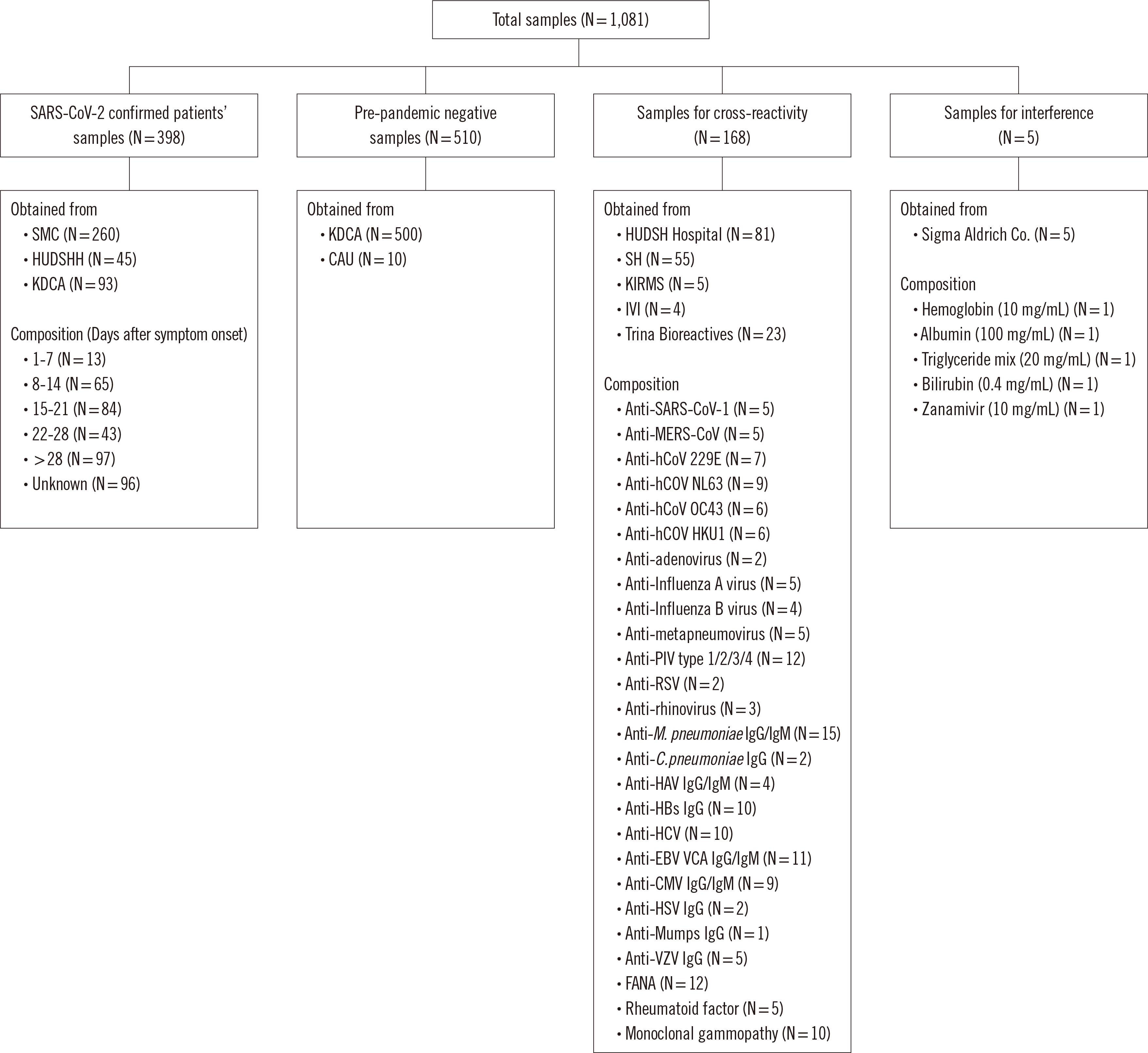1. Zhu N, Zhang D, Wang W, Li X, Yang B, Song J, et al. 2020; A novel coronavirus from patients with pneumonia in China, 2019. N Engl J Med. 382:727–33. DOI:
10.1056/NEJMoa2001017. PMID:
31978945. PMCID:
PMC7092803.

3. Gao Z, Xu Y, Sun C, Wang X, Guo Y, Ma K. 2020; A systemic review of asymptomatic infections with COVID-19. J Microbiol Immunol Infect. 54:12–6. DOI:
10.1016/j.jmii.2020.05.001.
4. Anand S, Montez-Rath M, Han J, Bozeman J, Kerschmann R, Beyer P, et al. 2020; Prevalence of SARS-CoV-2 antibodies in a large nationwide sample of patients on dialysis in the USA: a cross-sectional study. Lancet. 396:1335–44. DOI:
10.1016/S0140-6736(20)32009-2. PMID:
32987007. PMCID:
PMC7518804.

5. Clarke C, Prendecki M, Dhutia A, Ali MA, Sajjad H, Shivakumar O, et al. 2020; High prevalence of asymptomatic COVID-19 infection in hemodialysis patients detected using serologic screening. J Am Soc Nephrol. 31:1969–75. DOI:
10.1681/ASN.2020060827. PMID:
32732391. PMCID:
PMC7461667.

6. Pollán M, Pérez-Gómez B, Pastor-Barriuso R, Oteo J, Hernán MA, Pérez-Olmeda M, et al. 2020; Prevalence of SARS-CoV-2 in Spain (ENE-COVID): a nationwide, population-based seroepidemiological study. Lancet. 396:535–44. DOI:
10.1016/S0140-6736(20)31483-5. PMID:
32645347. PMCID:
PMC7336131.
7. Noh JY, Seo YB, Yoon JG, Seong H, Hyun H, Lee J, et al. 2020; Seroprevalence of anti-SARS-CoV-2 antibodies among outpatients in Southwestern Seoul, Korea. J Korean Med Sci. 35:e311. DOI:
10.3346/jkms.2020.35.e311. PMID:
32830472. PMCID:
PMC7445312.

8. Song SK, Lee DH, Nam JH, Kim KT, Do JS, Kang DW, et al. 2020; IgG Seroprevalence of COVID-19 among individuals without a history of the coronavirus disease infection in Daegu, Korea. J Korean Med Sci. 35:e269. DOI:
10.3346/jkms.2020.35.e269. PMID:
32715672. PMCID:
PMC7384903.

9. Cheng MP, Yansouni CP, Basta NE, Desjardins M, Kanjilal S, Paquette K, et al. 2020; Serodiagnostics for severe acute respiratory syndrome-related coronavirus 2: a narrative review. Ann Intern Med. 173:450–60. DOI:
10.7326/M20-2854. PMID:
32496919. PMCID:
PMC7281623.
10. Deeks JJ, Dinnes J, Takwoingi Y, Davenport C, Spijker R, Taylor-Phillips S, et al. 2020; Antibody tests for identification of current and past infection with SARS-CoV-2. Cochrane Database Syst Rev. 6:CD013652. DOI:
10.1002/14651858.CD013652. PMID:
32584464. PMCID:
PMC7387103.

11. Kontou PI, Braliou GG, Dimou NL, Nikolopoulos G, Bagos PG. 2020; Antibody tests in detecting SARS-CoV-2 infection: a meta-analysis. Diagnostics (Basel). 10:319. DOI:
10.3390/diagnostics10050319. PMID:
32438677. PMCID:
PMC7278002.

12. Mekonnen D, Mengist HM, Derbie A, Nibret E, Munshea A, He H, et al. 2021; Diagnostic accuracy of serological tests and kinetics of severe acute respiratory syndrome coronavirus 2 antibody: a systematic review and meta-analysis. Rev Med Virol. 31:e2181. DOI:
10.1002/rmv.2181. PMID:
33152146.

13. Hong KH, Lee SW, Kim TS, Huh HJ, Lee J, Kim SY, et al. 2020; Guidelines for Laboratory Diagnosis of Coronavirus Disease 2019 (COVID-19) in Korea. Ann Lab Med. 40:351–60. DOI:
10.3343/alm.2020.40.5.351. PMID:
32237288. PMCID:
PMC7169629.

14. Aoki K, Takai K, Nagasawa T, Kashiwagi K, Mori N, Matsubayashi K, et al. 2021; Combination of a SARS-CoV-2 IgG Assay and RT-PCR for Improved COVID-19 Diagnosis. Ann Lab Med. 41:568–76. DOI:
10.3343/alm.2021.41.6.568. PMID:
34108284. PMCID:
PMC8203440.

15. Kim IH, Kang BH, Seo SH, Park YE, Kim GJ, Lee SW, et al. 2021; Early Laboratory Preparedness of the Korea Disease Control and Prevention Agency and Response to Unknown Pneumonia Outbreak from Wuhan, China, in January 2020. Ann Lab Med. 41:532–9. DOI:
10.3343/alm.2021.41.6.532. PMID:
34108280. PMCID:
PMC8203432.

16. Yun S, Ryu JH, Jang JH, Bae H, Yoo SH, Choi AR, et al. 2021; Comparison of SARS-CoV-2 Antibody Responses and Seroconversion in COVID-19 Patients Using Twelve Commercial Immunoassays. Ann Lab Med. 41:577–87. DOI:
10.3343/alm.2021.41.6.577. PMID:
34108285. PMCID:
PMC8203431.

18. Irsara C, Egger AE, Prokop W, Nairz M, Loacker L, Sahanic S, et al. 2021; Evaluation of four commercial, fully automated SARS-CoV-2 antibody tests suggests a revision of the Siemens SARS-CoV-2 IgG assay. Clin Chem Lab Med. 59:1143–54. DOI:
10.1515/cclm-2020-1758. PMID:
33554557.

19. Schnurra C, Reiners N, Biemann R, Kaiser T, Trawinski H, Jassoy C. 2020; Comparison of the diagnostic sensitivity of SARS-CoV-2 nucleoprotein and glycoprotein-based antibody tests. J Clin Virol. 129:104544. DOI:
10.1016/j.jcv.2020.104544. PMID:
32663788. PMCID:
PMC7836838.

20. National SARS-CoV-2 Serology Assay Evaluation Group. 2020; Performance characteristics of five immunoassays for SARS-CoV-2: a head-to-head benchmark comparison. Lancet Infect Dis. 20:1390–400. DOI:
10.1016/S1473-3099(20)30634-4. PMID:
32979318. PMCID:
PMC7511171.





 PDF
PDF Citation
Citation Print
Print



 XML Download
XML Download